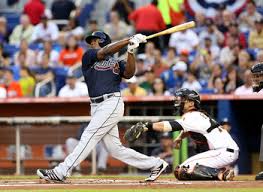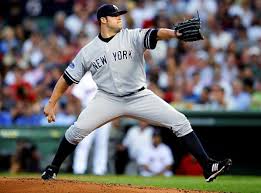Over the next several weeks, The Baseball Haven will be creating season previews for all 30 MLB teams. You’ll find their projected records (based on PECOTA records from Baseball Prospectus, as of 2/15/2015), each team’s top three players (based on Steamer WAR projections from FanGraphs), and some valuable notes on each team, including likely bounce-back candidates, potential breakout players or fantasy sleepers, as well as a look back at offseason transactions which led to each team’s projections. Stop back frequently to see where your favorite team ranks!
New York Yankees

2015 Projected Record: 80-82 (4th in AL East, 19th in MLB)
Manager: Joe Girardi (648-486 in seven seasons with New York, 726-570 in eight seasons overall)
Top Three Players: 3B Chase Headley (3.8), OF Jacoby Ellsbury (3.7), RHP Masahiro Tanaka (3.5)
Bounce-back Player: 3B/DH Alex Rodriguez
ARod is a miserable human being. He is a cheat, a liar, a disgrace to the game, and a $64 million financial burden over the next three seasons for a team that doesn’t appear to want anything to do with him. That appears to be fine for Rodriguez, who took to ESPN for a profile that painted him as a man who struggles with reality; however, the reality for baseball fans is that he is back on the field, healthy and rejuvenated, and ready to play and make an impact. His success depends on how much time the Yankees are willing to give him on the field. Since the club has Chase Headley, Garret Jones, and Mark Teixeira ahead of him on the depth charts at first, third, and DH, it remains to be seen how he will be used. Rodriguez, though, still has something left in the tank, working out with Barry Bonds (laugh and talk about PEDs all you want) to change his swing and strengthen his production as he ages. Rodriguez could be washed up or he could be a surprising producer. It may be unreasonable to ever expect good things from Rodriguez, on the field and off, but I see a man who, with 500 plate appearances, is capable of 20 to 25 home runs, making him quite useful -still- in an offense-starved league.

Fantasy Player to Watch: RHP Nathan Eovaldi
Eovaldi’s impressive fastball (4th fastest in MLB in 2014) has put him on the radar for a number of years, but he hasn’t taken a step toward dominance that many with similar electricity have. For example, even with the strong, dominant fastball, Eovaldi allowed 10.1 hits per nine, while striking out just 6.4 per nine. The positive in the low strikeout rate, however, is that Eovaldi walked just 1.9 per nine (3.3 K:BB), which may allow him to be a force if he was to miss a few more bats with his very straight fastball. While people may look to the fact that he is now pitching in the AL East and must deal with the incredible offenses there, you can look at a 25-year-old right-hander who is about to hit his peak. If Eovaldi is able to take a step forward, he’s going to take off and become quite dominant. If you can get him now, before that happens, you can thank me later.
Offseason Overview: The Yankees found their replacement for Derek Jeter when they acquired Didi Gregorius from the Arizona Diamondbacks in a three-way deal that included Shane Greene going to Detroit. Gregorius is now in his third organization, which shows that people still think he is valuable, but he had negative defensive value in 2014 and his .653 OPS doesn’t help his outlook if his defense is falling off. At just 25, he still has enough potential to outproduce Jeter. Eovaldi, as mentioned above, should be a nice addition to the staff, and with Masahiro Tanaka and Michael Pineda at the top of the rotation, they need Eovaldi to produce and be healthy, something they can’t quite count on out of the other two. Dellin Betances should step right into the closer’s role and be an Aroldis Chapman–Craig Kimbrel type of dominator, which is necessary after David Robertson left for Chicago. Re-signing Headley at third base was necessary due to the unknown of Alex Rodriguez, and Stephen Drew was brought back after a horrific 46 game audition last season, but both are more capable with their gloves than they are with their bats. The Yankees could have one of the best defensive clubs in baseball in 2015 for that reason.
After an offseason of preparation, @CC_Sabathia is ready to compete. http://t.co/M4Igrz0sB9 (via @YankeesonDemand) pic.twitter.com/4mGUkzqwTp
— New York Yankees (@Yankees) March 20, 2015
The Verdict: The Yankees aren’t going to be worse in 2014. A full season of Headley should outproduce what Yangervis Solarte was able to do in 2014, and there is more to Brian McCann (.692 OPS), Teixeira (.711 OPS), and Jacoby Ellsbury (.747 OPS) than what they showed last season. The biggest question mark is their pitching. Michael Pineda threw 76.1 innings in 2014, his first in the majors since 2011, after having dealt with major shoulder issues, Masahiro Tanaka is pitching through a partially torn UCL, and CC Sabathia missed all but eight starts due to a right knee injury. Are they going to get enough out of these three to remain competitive? They have Scott Baker, Chris Capuano, and Ivan Nova as pitching depth, but if those three make significant contributions, the Yankees are going to be in really bad shape. It is fair to highly doubt that Tanaka makes it through the 2015 season, and, for that reason, the club will, at some point, be without a number one starter. It also seems fair to think that a winning season is highly unlikely without things breaking completely right. Those things include:
1) 180 or more innings from Tanaka, Pineda, and Sabathia
2) More productive seasons from Headley, Drew, Ellsbury, Teixeira, and McCann
3) A miracle
The Yankees PECOTA seems right in 2015, but without the above things happening, it is doubtful that they reach 80 wins.
- 2015 Season Preview: Arizona Diamondbacks (3/1/2015)
- 2015 Season Previews: Atlanta Braves (2/28/2015)
- 2015 Season Previews: Baltimore Orioles (3/4/2015)
- 2015 Season Previews: Chicago Cubs (4/1/2015)
- 2015 Season Previews: Chicago White Sox (3/4/2015)
- 2015 Season Previews: Cincinnati Reds (3/11/2015)
- 2015 Season Previews: Colorado Rockies (2/24/2015)
- 2015 Season Previews: Houston Astros (3/1/2015)
- 2015 Season Previews: Kansas City Royals (2/25/2015)
- 2015 Season Previews: Milwaukee Brewers (3/11/2015)
- 2015 Season Previews: Minnesota Twins (2/21/2015)
- 2015 Season Previews: New York Mets (4/1/2015)
- 2015 Season Previews: Philadelphia Phillies (2/20/2015)
- 2015 Season Previews: Pittsburgh Pirates (3/22/2015)
- Season Previews: Miami Marlins (3/25/2015)





























